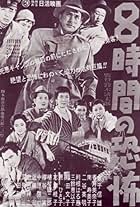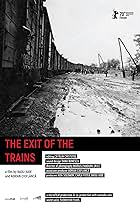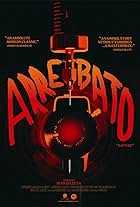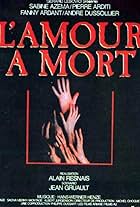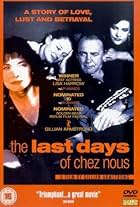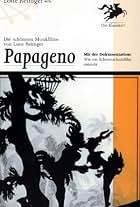What happens after the curtain falls on the death of Mimi, tragic heroine of Puccini's La boh?me? In Thriller, Mimi teams up with the opera's comic heroine Musetta to investigate her own dea... Read allWhat happens after the curtain falls on the death of Mimi, tragic heroine of Puccini's La boh?me? In Thriller, Mimi teams up with the opera's comic heroine Musetta to investigate her own death.What happens after the curtain falls on the death of Mimi, tragic heroine of Puccini's La boh?me? In Thriller, Mimi teams up with the opera's comic heroine Musetta to investigate her own death.
Photos
- Director
- Writer
- All cast & crew
- Production, box office & more at IMDbPro
Storyline
Did you know
- TriviaRose English's debut.
- ConnectionsFeatured in Visions: Two Directors: Wendy Toye and Sally Potter (1984)
- SoundtracksLa Boheme
Music by Giacomo Puccini
Featured review
As a note there is no way to spoil the plot of this independent film.
Thriller is not an easy film to digest by any standards and this made it difficult for any concrete evaluation. The film requires multiple viewings and is designed to be viewed in such a manner. After the second viewing a few concrete themes seemed to repeat themselves and provided a small glimpse into the essence of this powerful film.
The film has no narrative and comes across as a deep symbolic metaphor for the existential elements of human life. There is a neutral gaze that allows us to view the subject, Mimi1/2, as a conflicted object for our intuitive gaze. Potter plays out her existential dilemma through symbolic representation. One thing I noticed right away was the use of the attic as the mise-en-scene. The attic appeared to function as a receptacle of lost dreams and desires: like the typical use of an attic in a house is to collect materials that we aim to forget about. This setting allows for a visual nod to ambiguity, that the return to the attic is to face unanswered truths that have been placed away to be forgotten.
The film is an attack on Freudian concepts and plays them out through other symbolic situations such as the mirror. The gaze Mimi has in the mirror plays an internal psychological battle between herself and her perception of herself. Since Mimi only sees herself in the mirror as expecting to see something else, an answer perhaps, she is left with only the other images she has experienced to fill in the void of her personal understanding of life. And since these images come from an external source and not from a defined internal voice Mimi is caught in her own existential dilemma.
In Ann Kaplan's 1983 personal dissertation on film theory, "Women and Film", she argues that Potter's film is a feminist counter to contemporary art forms. I tend to disagree with Kaplan on some of her key assertions about this film. I find it way more complex than she seems to find it. Although, I agree with most of her main premise, I tend to see the film as being far more than an attack of Freudian theory, or for that matter women of the industrial age. Potter's film, since it is so symbolic, struggles more with the images that women receive, rather than a complete psychological evaluation. I feel if Sally Potter were deliberately seeking to critique Freud, she would have a complete narrative that would play out, with detail, the psychological ambitions of Mimi 2. Rather she uses larger symbolic notions that are incomplete and fleeting to show a far more existential contemplation of a female existence, while employing a direct critique of Freud. She does this, in true Marxian theory, to not exclude viewership.
This interpretation merely scratches the surface in which Sally Potter's visual manifesto portrays women. Potter's film is a formic "call-to-arms", a Marxists revolution on film as an art form. Like Karl Marx's Communist Manifesto, Thriller leaves the viewer with one open interpretation that should be used as a tool for redefining cinema and not simply a response to Freud.
Thriller is not an easy film to digest by any standards and this made it difficult for any concrete evaluation. The film requires multiple viewings and is designed to be viewed in such a manner. After the second viewing a few concrete themes seemed to repeat themselves and provided a small glimpse into the essence of this powerful film.
The film has no narrative and comes across as a deep symbolic metaphor for the existential elements of human life. There is a neutral gaze that allows us to view the subject, Mimi1/2, as a conflicted object for our intuitive gaze. Potter plays out her existential dilemma through symbolic representation. One thing I noticed right away was the use of the attic as the mise-en-scene. The attic appeared to function as a receptacle of lost dreams and desires: like the typical use of an attic in a house is to collect materials that we aim to forget about. This setting allows for a visual nod to ambiguity, that the return to the attic is to face unanswered truths that have been placed away to be forgotten.
The film is an attack on Freudian concepts and plays them out through other symbolic situations such as the mirror. The gaze Mimi has in the mirror plays an internal psychological battle between herself and her perception of herself. Since Mimi only sees herself in the mirror as expecting to see something else, an answer perhaps, she is left with only the other images she has experienced to fill in the void of her personal understanding of life. And since these images come from an external source and not from a defined internal voice Mimi is caught in her own existential dilemma.
In Ann Kaplan's 1983 personal dissertation on film theory, "Women and Film", she argues that Potter's film is a feminist counter to contemporary art forms. I tend to disagree with Kaplan on some of her key assertions about this film. I find it way more complex than she seems to find it. Although, I agree with most of her main premise, I tend to see the film as being far more than an attack of Freudian theory, or for that matter women of the industrial age. Potter's film, since it is so symbolic, struggles more with the images that women receive, rather than a complete psychological evaluation. I feel if Sally Potter were deliberately seeking to critique Freud, she would have a complete narrative that would play out, with detail, the psychological ambitions of Mimi 2. Rather she uses larger symbolic notions that are incomplete and fleeting to show a far more existential contemplation of a female existence, while employing a direct critique of Freud. She does this, in true Marxian theory, to not exclude viewership.
This interpretation merely scratches the surface in which Sally Potter's visual manifesto portrays women. Potter's film is a formic "call-to-arms", a Marxists revolution on film as an art form. Like Karl Marx's Communist Manifesto, Thriller leaves the viewer with one open interpretation that should be used as a tool for redefining cinema and not simply a response to Freud.
Details
- Runtime34 minutes
- Color
- Sound mix
Contribute to this page
Suggest an edit or add missing content




